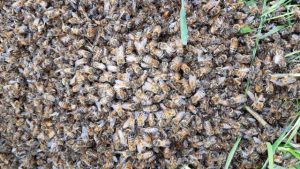Honey bees hit by rise in disease linked to climate change with Yorkshire, Norfolk and South West worst hit
New study finds that for every 1C (1.8F) of warming the risk of catching a disease caused by a varroa mite jumps by 39 per cent
Chronic bee paralysis virus pile of dead bees (Mike Brown)
By Tom Bawden
Science & Environment Correspondent
Climate change has significantly increased the risk of honey bees catching fatal diseases – and has made the south west of England a hotspot for the deadly varroa mite, a study finds.
Researchers have found that for every 1C temperature increase honey bees are 39 per cent more likely to become infected by varroa mites, which favour warmer climates.
North Yorkshire, Lincolnshire and Norfolk are also being hit by increases in mite numbers.
Top of Form
Bottom of Form
Powys, Shropshire, Herefordshire and Worcestershire have emerged as a hotspot for the serious bacterial honey bee disease European Foulbrood, amid rising temperatures, the study found.
“These results are worrying because they show that serious diseases like Varroa continue to increase in UK honey bee populations – and it seems that there are clear climatic variables that further increase the risk of disease,” lead researcher, Newcastle University PhD student Ben Rowland, told i.
The impact of climate change is piling further pressure on honey bees, a group of beleagured pollinators that play a key role in food production and is already being hit hard by habitat destruction and pesticides.
Professor Giles Budge, also of Newcastle University, added: “We have long known that weather can influence the ability of honey bees to leave the hive and forage for food. This new knowledge will help us predict how honey bee disease might be influenced by future climate change.”
The study also found that the windier, rainier weather that also results from climate change reduces the risk of honey bee disease, this is outweighed by the effect of temperature increases.
The study is published in the journal Scientific Reports.
It involved data collected from visits to over 300,000 colonies on how the prevalence of six important honey bee diseases were affected by rainfall, temperature and wind levels.







